Since the late 1800s, there has been a market for a diverse range of aesthetically pleasing and practically useful products that fall under the category of antique glass. Plates, bowls, vases, and glasses are all examples of the many categories of antique glassware.
You could purchase these exquisite things from the glass industry to put on display in your home, or you could put them to use in the kitchen or while you’re entertaining guests.
You should be aware that cut glass dates back about 2,000 years and is considered to be the most valuable kind of antique glass. Other popular types include art, pressed, depression, carnival, milk, and elegant glassware.
Milk bottles and other glassware was popular during the carnival era. There had been engraved signatures, makers marks, diamond mark, paper label, and acid etched mark to determine approximate date range of the glass.
Now that we have that out of the way, let’s talk about recognizing antique glass with the help of a particular mark.
Table of Contents
What Factors Affect Value of a Glass
There are various methods that may be used to determine the age of a piece of antique glass even if it does not have a mark or signature. The value of a piece of glass may decrease if it has any chips in it. They have a depth that can be experienced and can be felt.
The value of the glass pieces will vary depending on the size of the chip as well as the size of the piece of glass that is being sold.
Chips
If you touch fresh chips, they will have sharp edges, however, chips that have been used for a long period would likely have dulled edges.
Cracks
Take the piece of glass outside into the sunshine so you can inspect it for any minute fractures that would be invisible under the lighting conditions inside. Cracks have the effect of dramatically lowering the value of a piece.
Flaking
The rim of an antique piece of glass is often the first place to show signs of flaking. A flake is a little piece of glass that is flat and very thin, yet its presence does not lower the object’s value.
Nicks
Nicks is missing fragments of glass pieces around the size of a pinhead. However, their presence does not impact the piece’s value. Depending on the age of the object, even while it won’t be in perfect condition, it probably won’t be deemed damaged either.
Rough Spots
If you run your finger around the rim or base of a drinking glass or goblet, you should be able to locate any rough spots or areas on the surface.
Scratches
Scratches, which are often an indication of age, may be seen on the bottom of an old piece of glass. In an earlier artwork, they will often travel in all different directions. However, on a more recent one, they will all be heading in the same general direction. This is especially obvious when looking at replica works.
In the same way that pottery and porcelain are manufactured, more modern pieces of glass may be cast from antique molds. However, the composition of the glass will be changed, which will result in a reduction in weight.
Types of Antique Glass
Art Glass
Art glass is a kind of vintage glass that was first established in the early 1900s by glassmakers who were interested in developing innovative patterns for their products.
As a result of their labor, a wide array of handcrafted goods in art glass were produced, including beer bottles, bowls, vases, and other things. In addition, many items included vibrant colors, iridescent qualities, or patterns that were derived from the natural world.
Quezal, Tiffany, Durand, and Steuben are among the most well-known names in the history of art glass making, but other enterprises have contributed to the development of several styles.
Vintage frosted art glass pieces
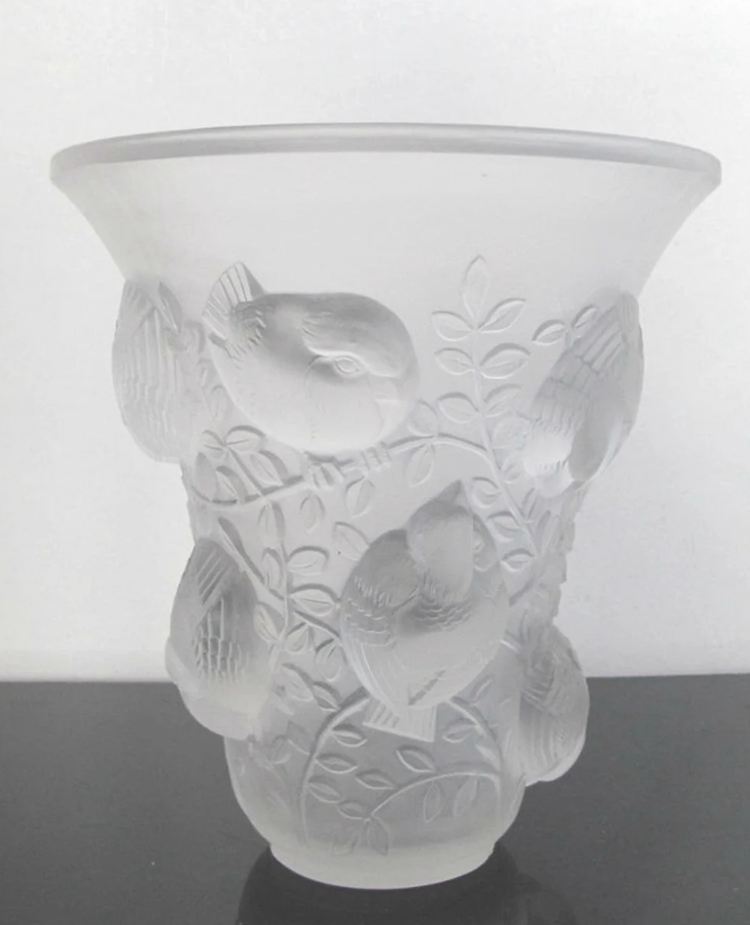
Bohemian art glass vase
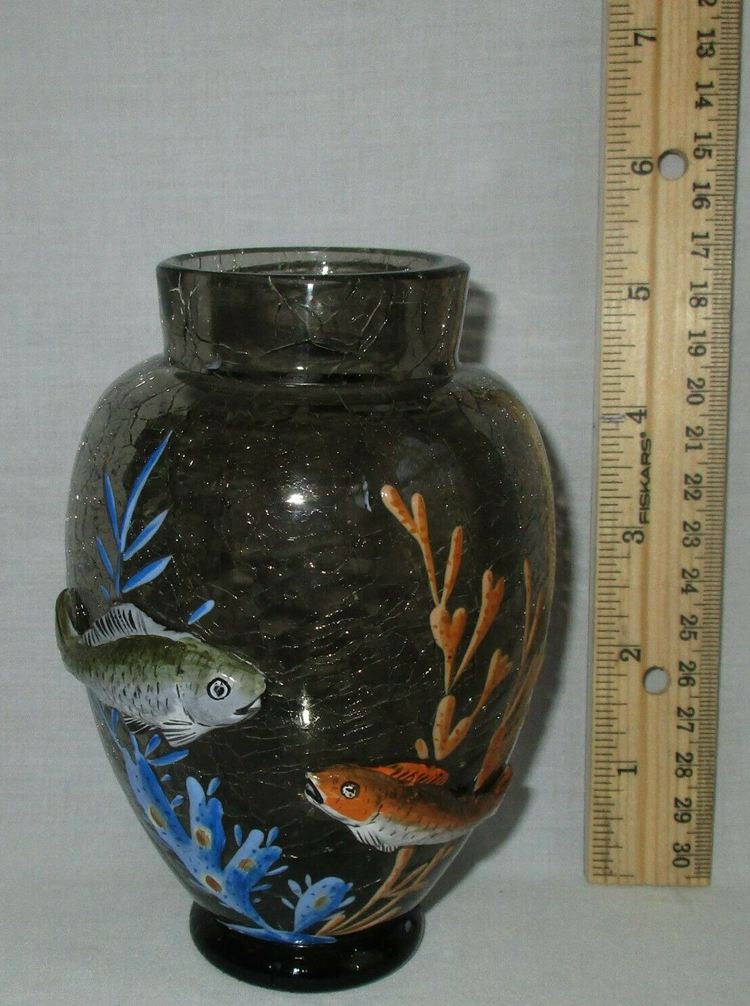
Deco style art glass
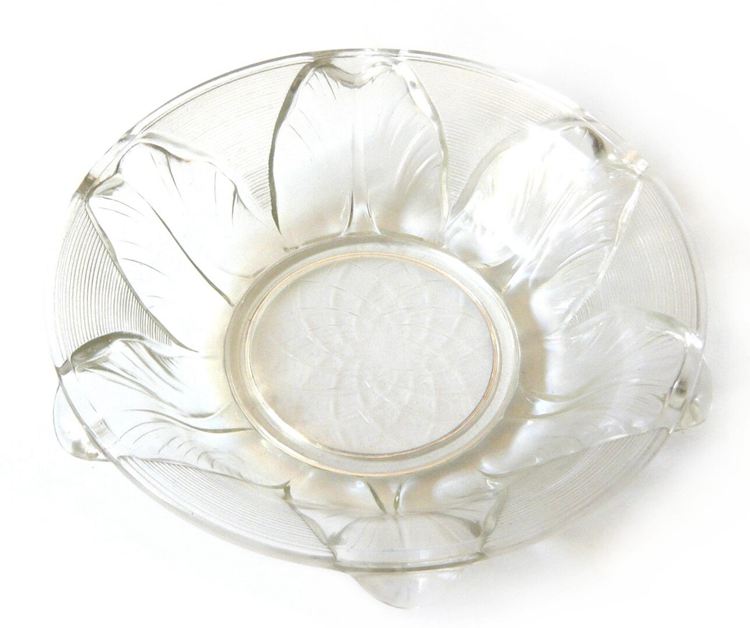
Art Nouveau period pressed glass thistle
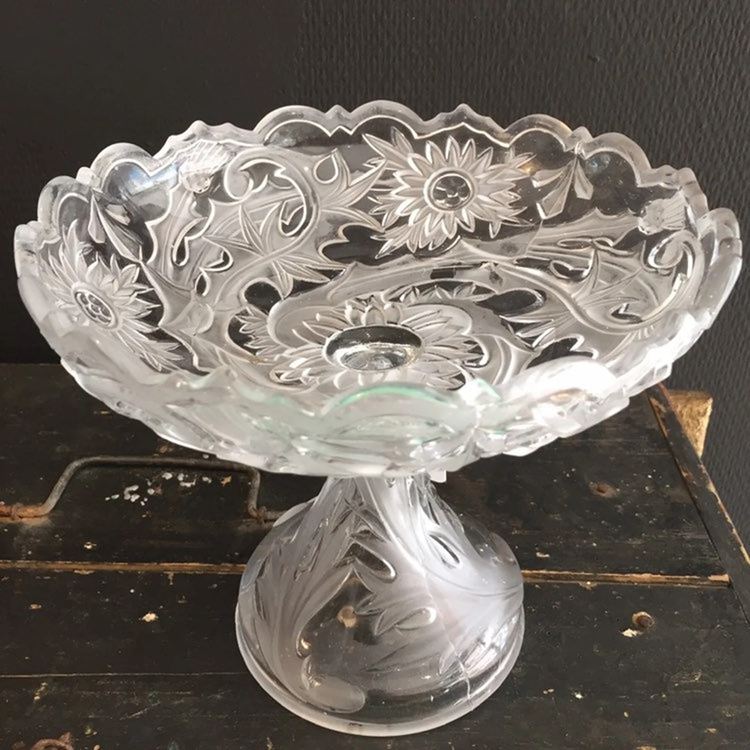
Art Nouveau Kralik vase
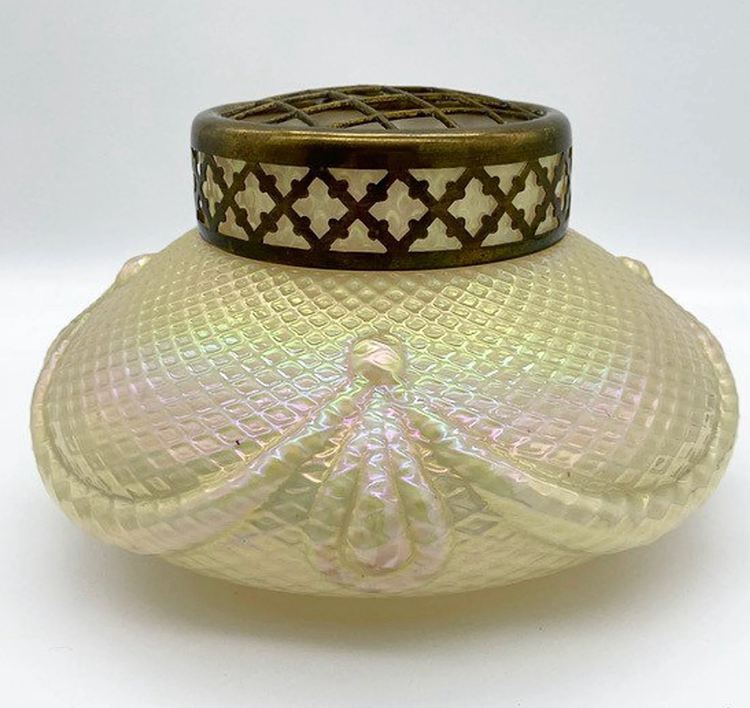
After the end of the Art Nouveau period, art glass pieces lost some of their popularity, but throughout the 1950s and 1960s, collectors began to take an interest in the medium once again. However, the price of a certain art Nouveau antique glass piece may vary depending on its worth, despite the fact that it continues to be a popular option among collectors of vintage glass today.
Examine the antique glass markings, engraved signatures, or other markings that are found underneath the art glass to discover who its creator was. However, if you want to avoid buying a replica, you will need to have a comprehensive understanding of the colors, styles, and other markings that are found in authentic works.
Carnival Glass
The Fenton Glass Company first introduced this kind of glassware in 1907 under the name “Carnival Glass.” It was developed with the intention of becoming a more affordable substitute for Tiffany’s Favrile antique glass.
Despite this, many were hesitant to shell out a significant amount of money for them. Therefore, they were presented to the winners of various carnival games as prizes, which is how the term “carnival glass” came to be used.
Carnival Glass 1970
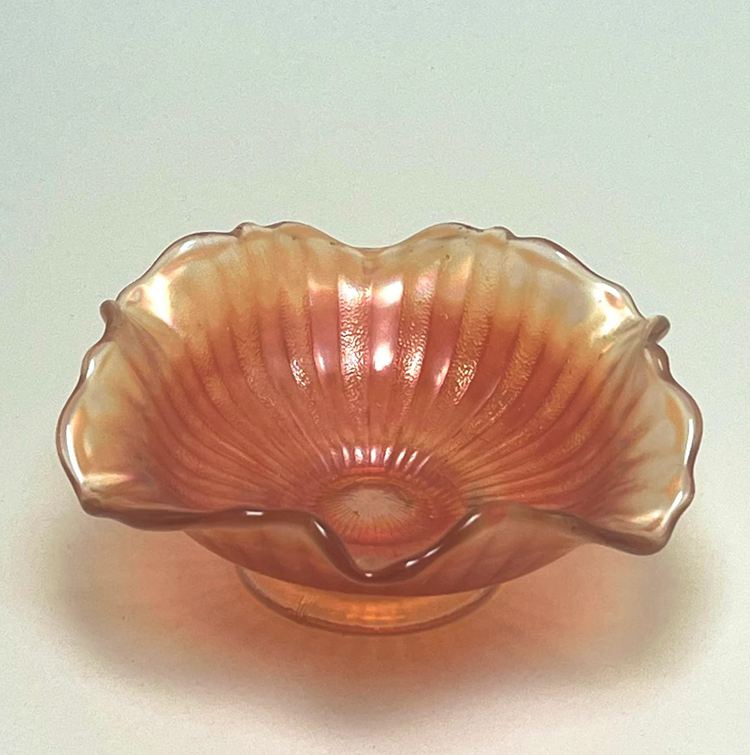
Vintage Iridescent Carnival Glass Cups
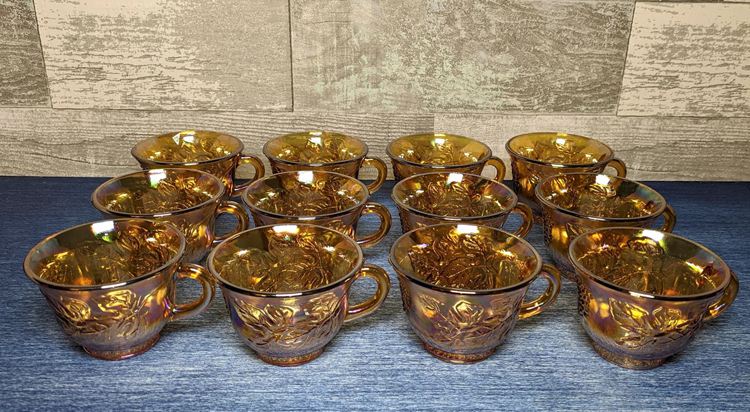
Vintage 9.5″ Carnival Glass Plate
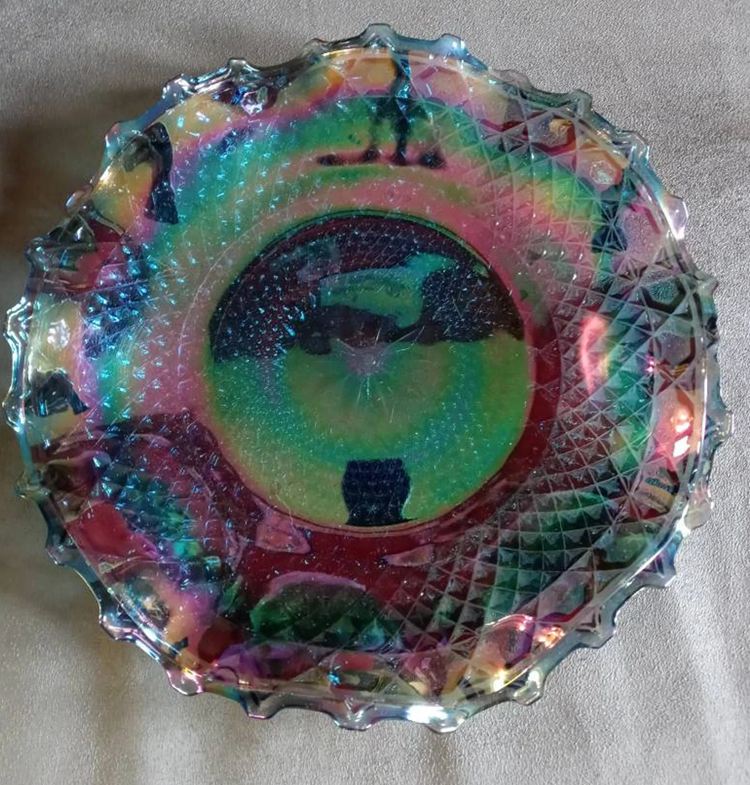
Green Carnival Glass Punch Glasses
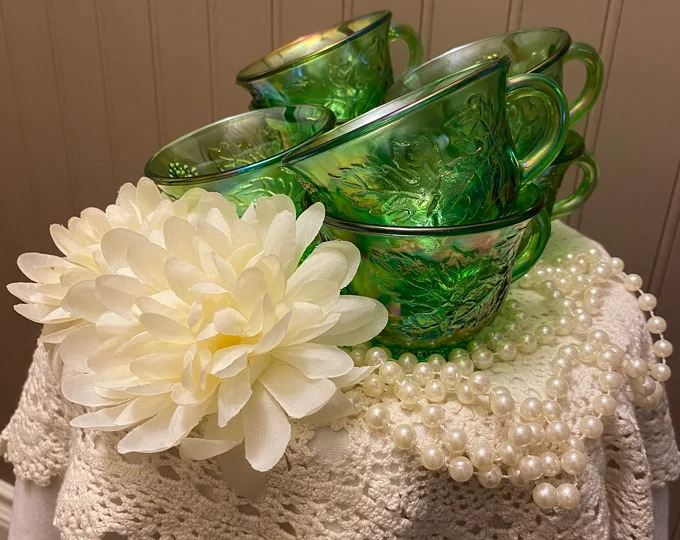
Round Green Glass Plate
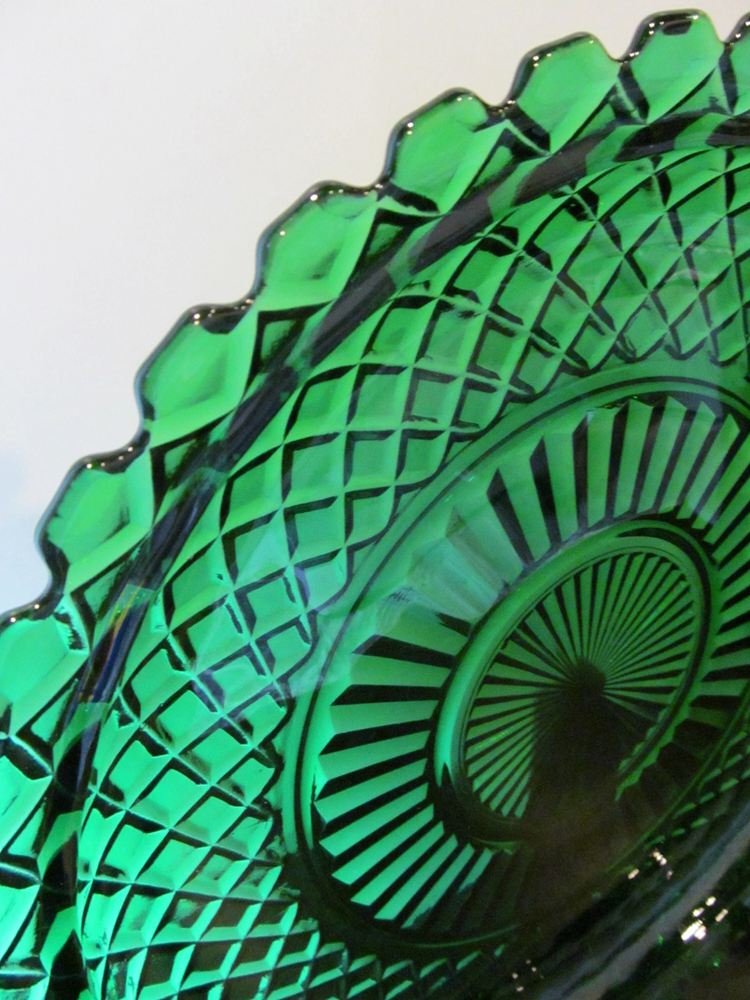
In 1925, carnival glass lost its significance, and its popularity would not recover until the 1950s when people became interested in the decorative possibilities of the material again.
This particular kind of antique glass is often characterized by a multicolored sheen that, depending on the perspective from which it is seen, may exhibit a variety of distinct hues.
In addition, the price of these collectibles is determined by the year in which they were produced, as well as their dimensions, types, colors, and levels of preservation.
Complete sets, enormous individual parts, and individual pieces created before the 1940s all have a high value. In addition, pieces with an icy green or marigold tint have a value of many thousands of dollars.
Crystal Glassware
This form of glassware is comparable to conventional glass. However, it is of superior quality and is created from lead. Crystal glassware may be identified by its clear appearance.
Due to the reflected qualities of these pieces, wealthy collectors began using the use of these pieces for serving in the 19th century. Pieces that date from this era are considered antique by collectors.
On the other hand, crystal glassware made after the first world war and produced after that time is considered to be vintage. The look and the sound of a piece of crystal glassware are the two characteristics that may be used to identify it.
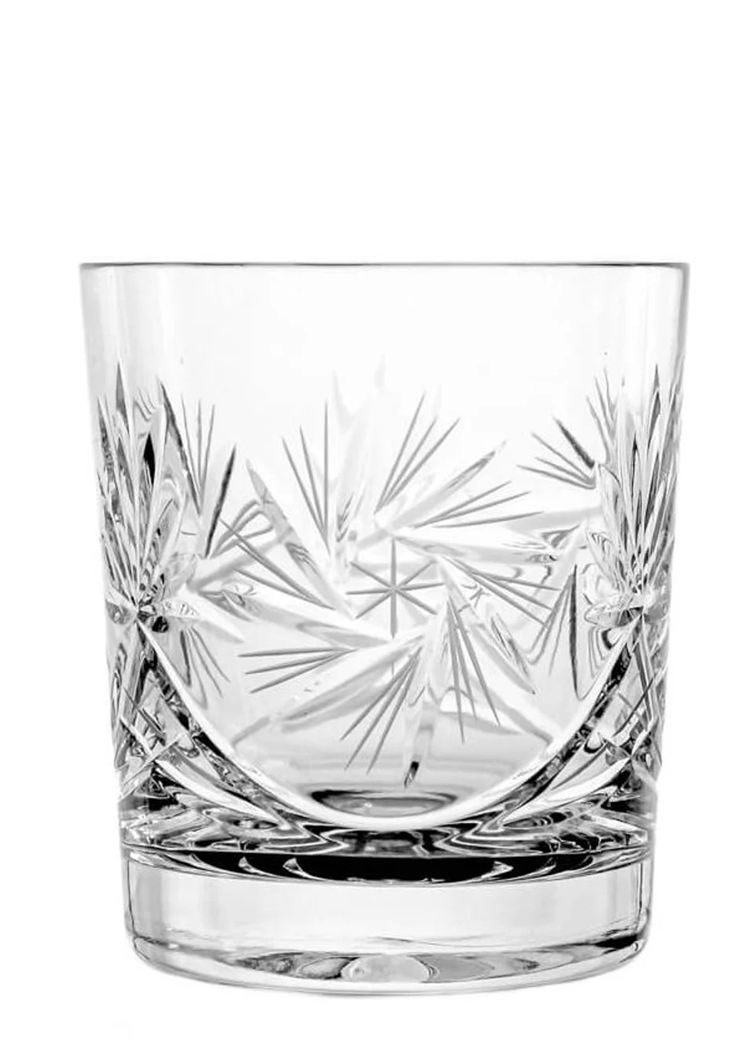
20th Century Wine Glass
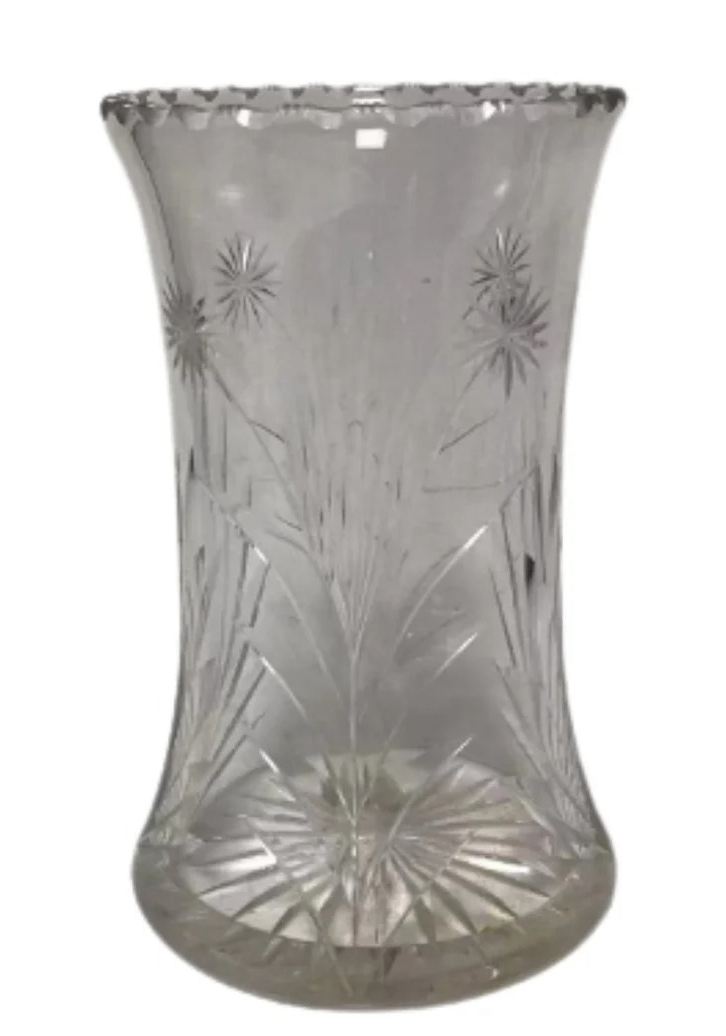
Vintage Cocktail Champagne Coupe Glasses
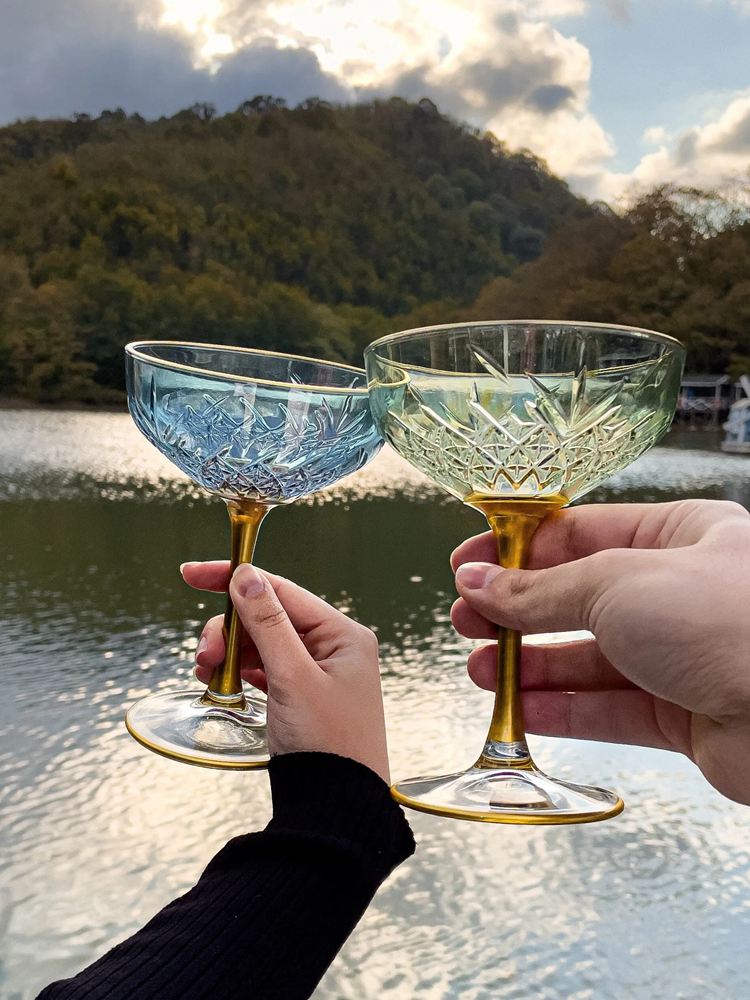
Baccarat Antique Crystal Liqueur Glasses
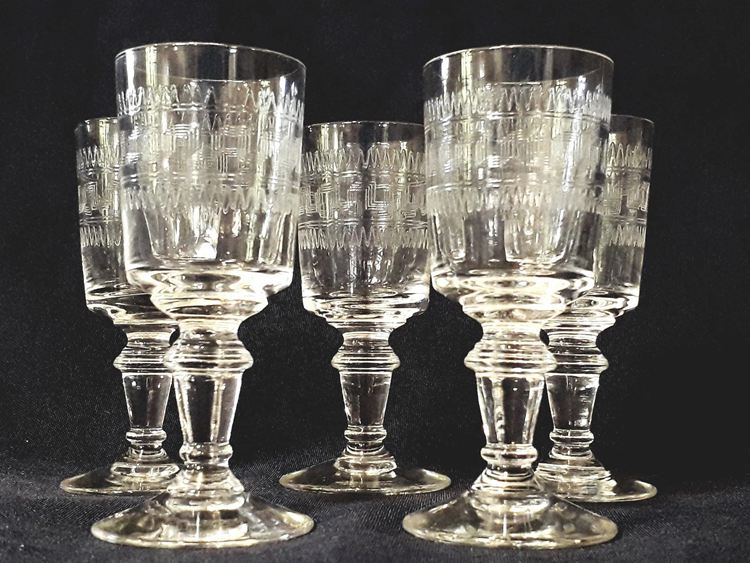
Antique Etched Glass
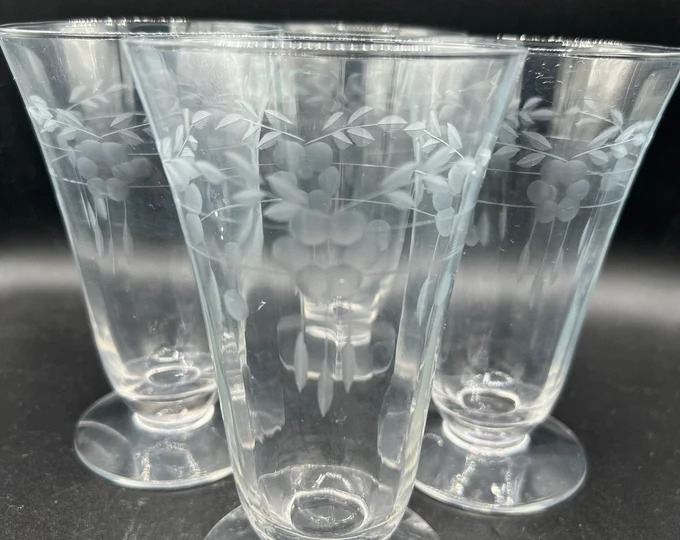
Crystal glasses are made of normal glass, but it is more robust, heavier, and smoother than crystal glassware because of the lead substance that is utilized in its creation. In addition to this, it is capable of reflecting light, which results in a pastel prism of hues.
A “ping” sound will be produced when true crystal glassware is tapped. It is common practice for major manufacturers of crystal glassware to affix their signature or name to the bottom of their items so that customers can easily identify them. These signed art glass pieces have greater value than others.
Crystal glassware may be found at a variety of price points, but the pieces made during the American Brilliant era are consistently the most costly. The maker, the design, and the condition of an item will each play a role in determining the piece’s worth.
Depression Glassware
Glassware known as Depression Glass, which began in 1929, was a contributing factor in the creation of inexpensive glass known as depression glass. There have their specific antique glass marks.
In spite of the challenging circumstances, individuals were able to have something for their day-to-day usage, for serving visitors, and for adorning their living space because of the accessibility of these items.
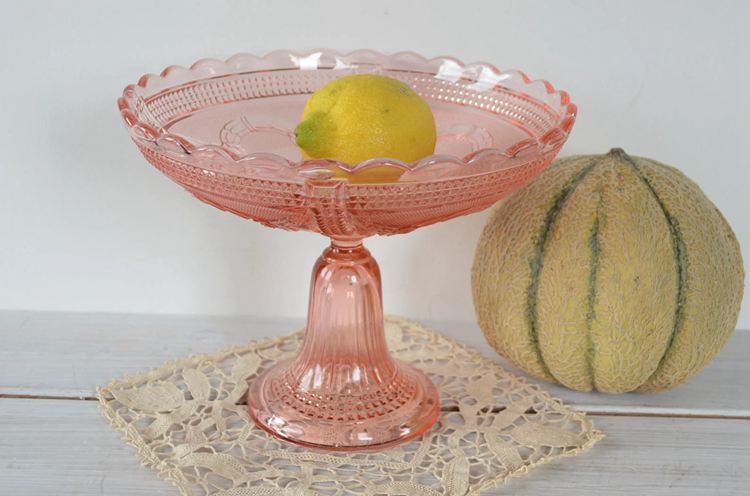
Vintage Normandie Depression Pressed Dishes
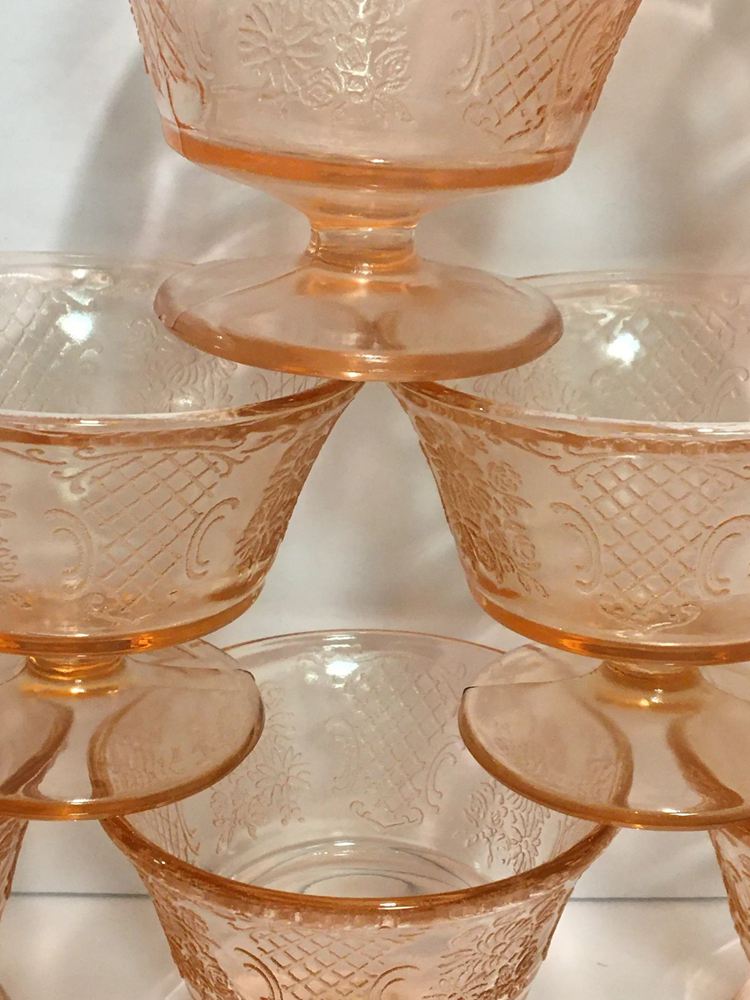
McBeth Evans Depression Antique Glassware
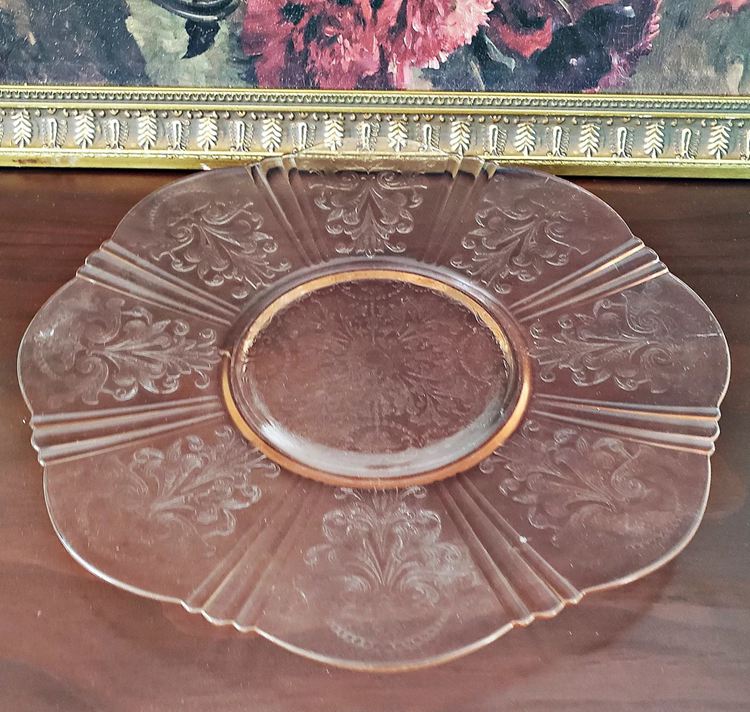
Vintage Depression Glass Set
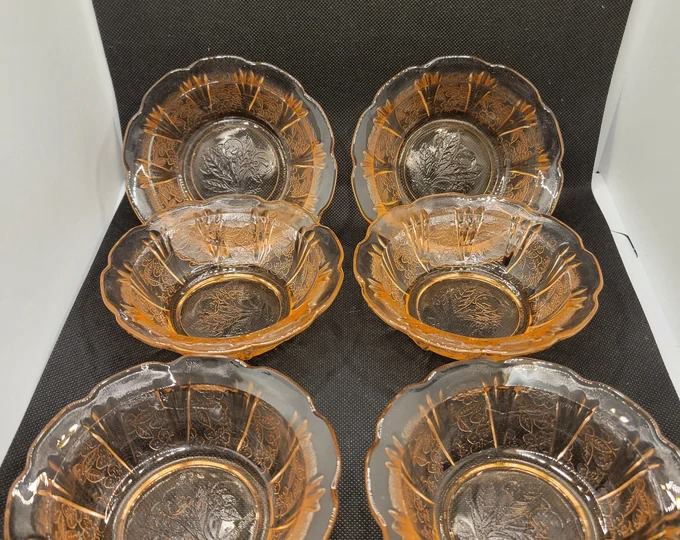
Vintage pink and gold depression antique glassware
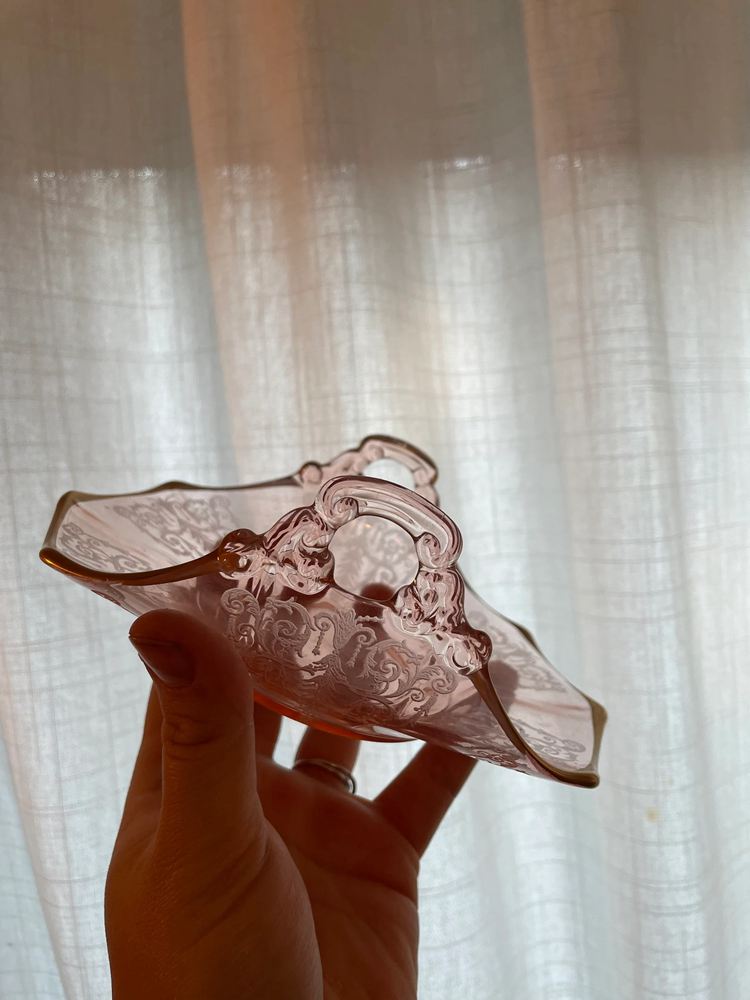
There is a significant amount of variation in the hues, dimensions, and designs that are available for Depression antique glassware. These items are well-known because of the etched motifs, geometric bodies, and opalescent trims that they have.
Depression glassware was notorious for having imperfections due to the adoption of less expensive production methods. However, despite these imperfections, the value of the items has not been diminished in any way.
Instead, they facilitate the process by which collectors may identify original works. The condition of an item, as well as its color, kind, and design, will all have an impact on the price.
In addition, the ones that are the rarest, have the most exquisite designs, have been in the best condition, and are green and pink in hue are the most precious.
Depression glass was produced by a number of companies, but one of the most notable was the Jeannette Bottle Works.
Elegant Glassware
Despite the fact that the Great Depression caused many businesses to switch to the production of less expensive glassware, several firms maintained their production of high-end elegant glass.
These items were referred to as beautiful or elegant glass and were crafted by persons who had a lot of hands-on experience. They were pretty pricey too.
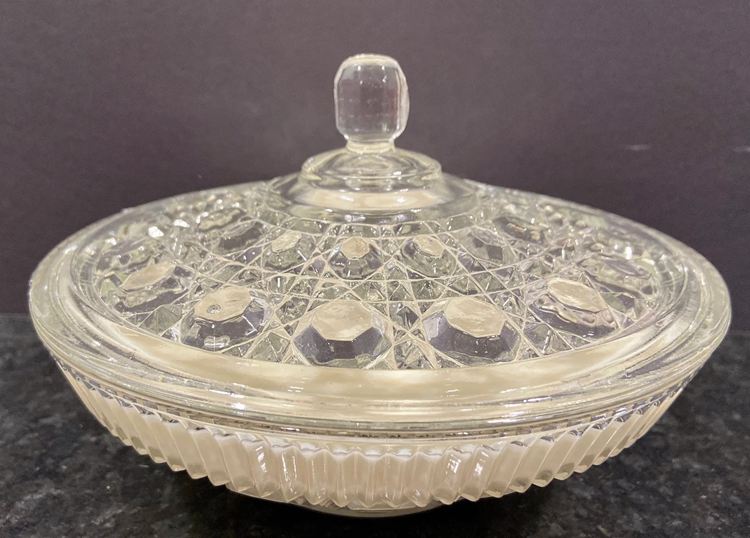
Vintage Set of 4 elegant Gilded Glass
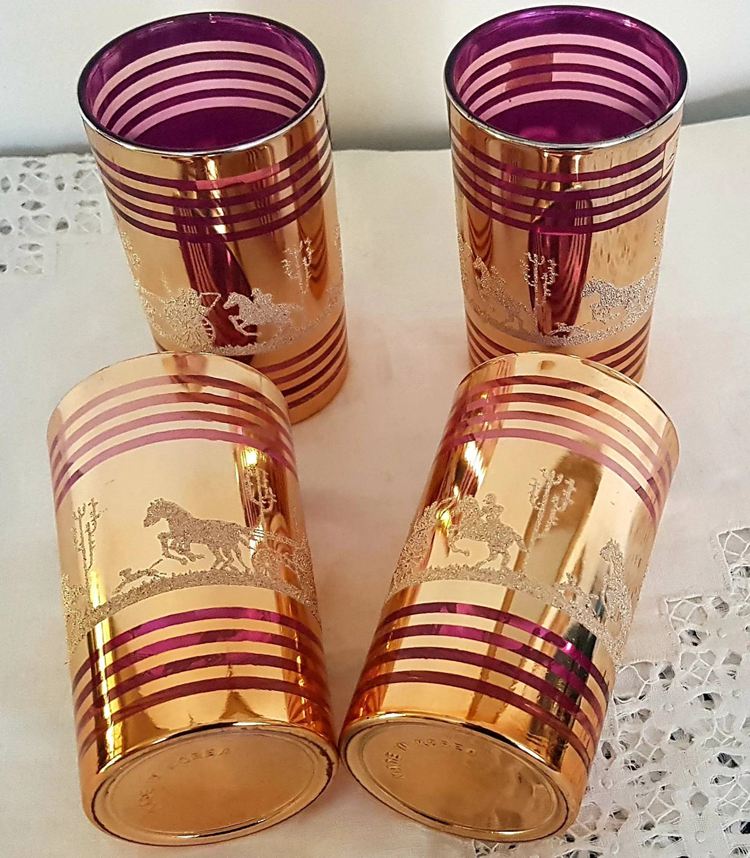
Gold Encrusted Optic Flat Juice Tumbler Glasses
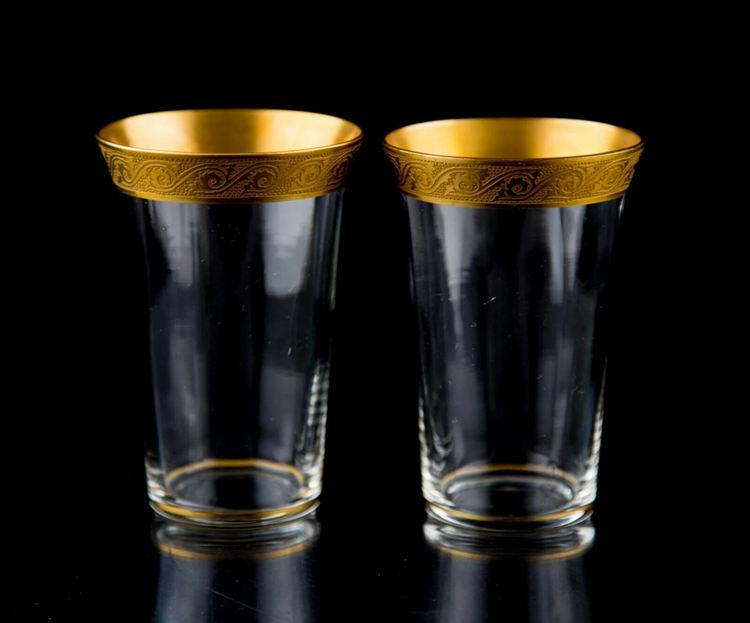
Short Stemmed Champagne Flutes
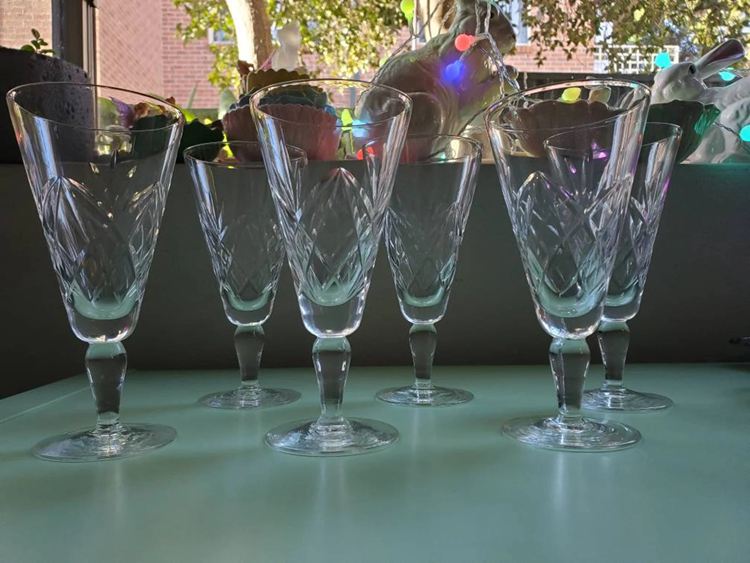
Elegant Vintage Modern Wine Glass
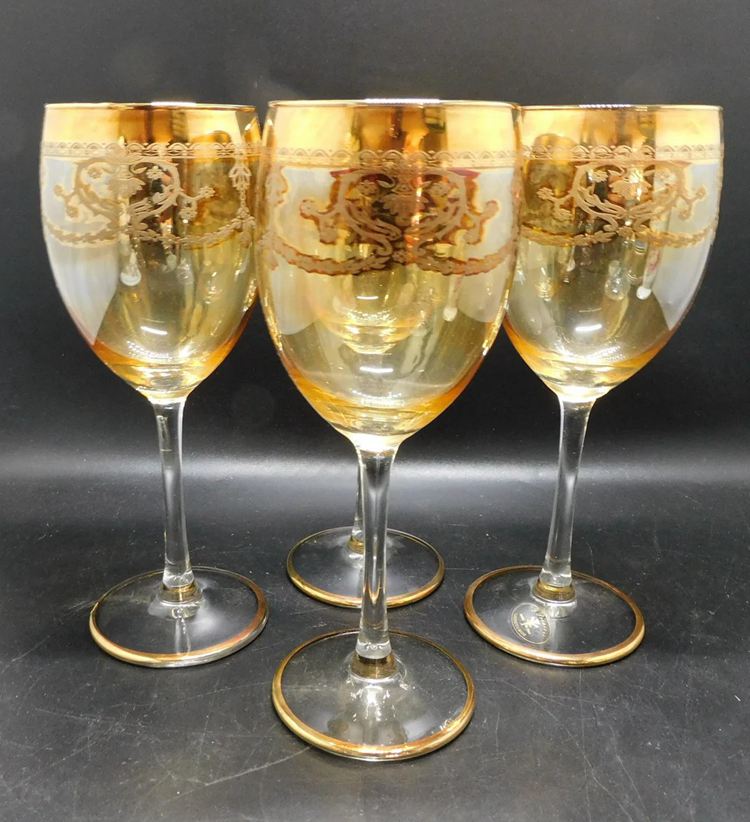
Elegant glass, much like depression glassware, is available in a variety of hues and elaborate design patterns. However, the production process for each of them is unique.
Much like other kinds of antique glass pieces, it is often valued according to the year in which it was produced, the kind of glass, the color, and the design. Items such as candle holders have a value of around $16 each.
In the meanwhile, the value of an elegant glass set that is complete, of a single hue, and in excellent condition might reach several thousand dollars. The Fostoria Glass Company and the Imperial Glass Corporation are examples of well-known companies that manufacture exquisite glassware.
Kitchen Glassware
Glassware for the Kitchen is an example of the kind of glassware known as depression glassware, which was popular during the Great Depression. The fact that these items could be purchased for a low price made them a well-liked option for use in the kitchen.
Jadeite, Delphite, Platonite, and Fire King are several varieties of glass that are used in the production of kitchen glassware. Every one of these varieties of glass has its own set of unique characteristics.
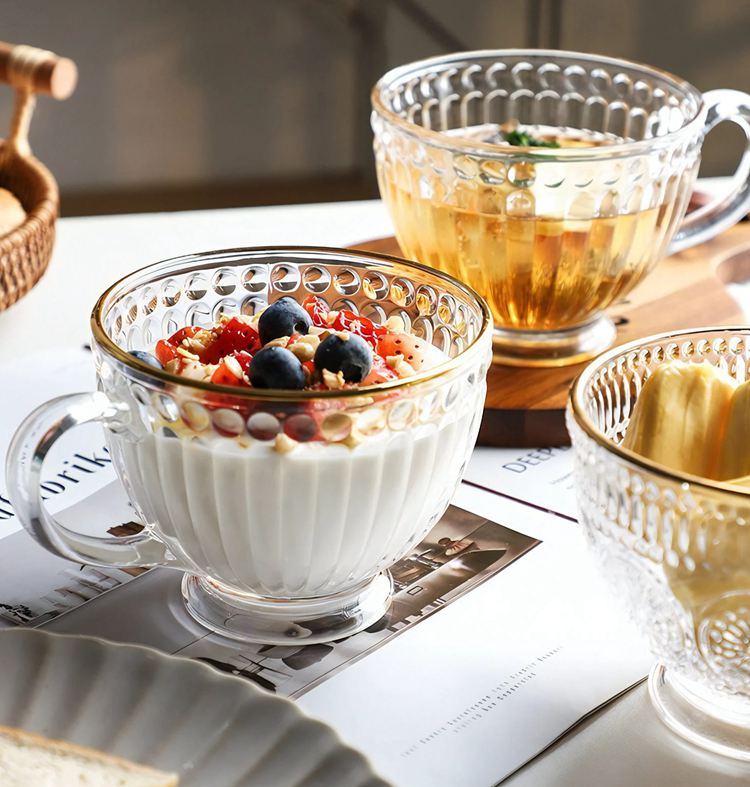
Vintage Libby drinking glasses
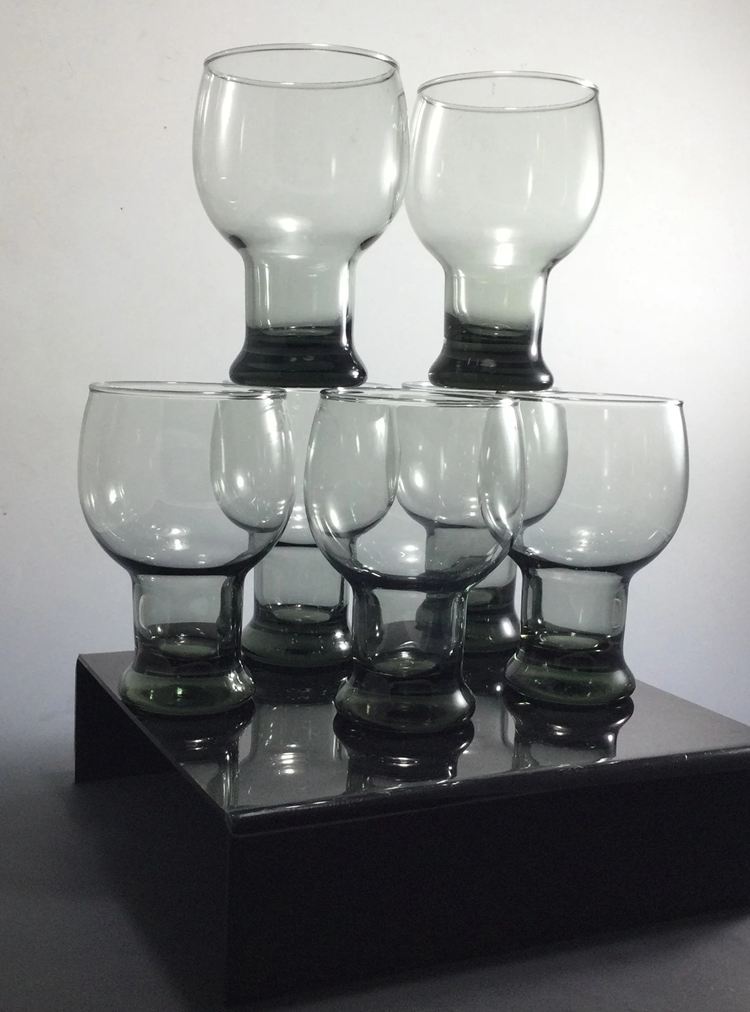
Vintage Glass Ball Canning jars
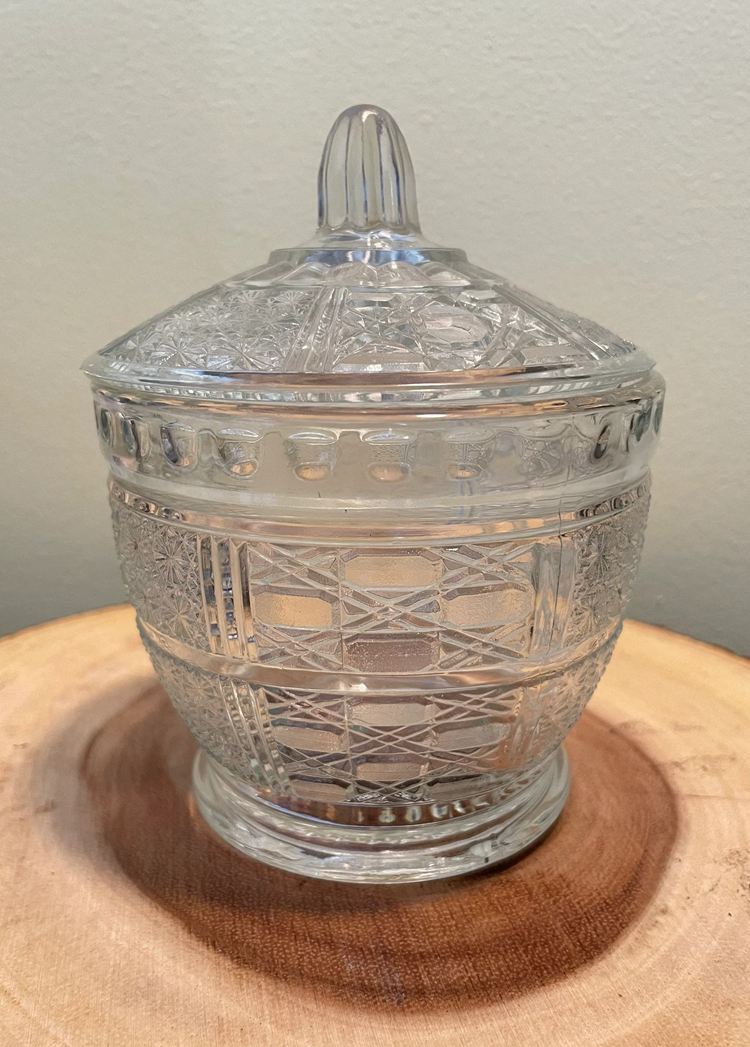
Vintage depression glass salt pepper shakers
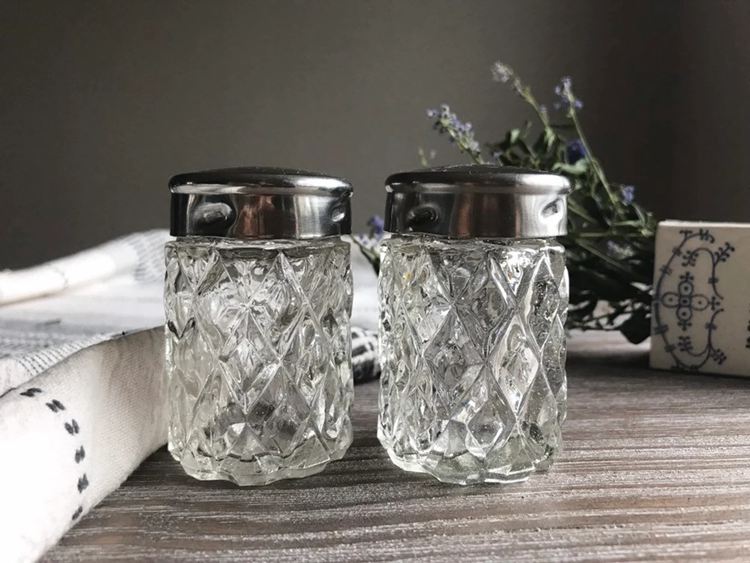
Heavy Crystal Whiskey Decanter
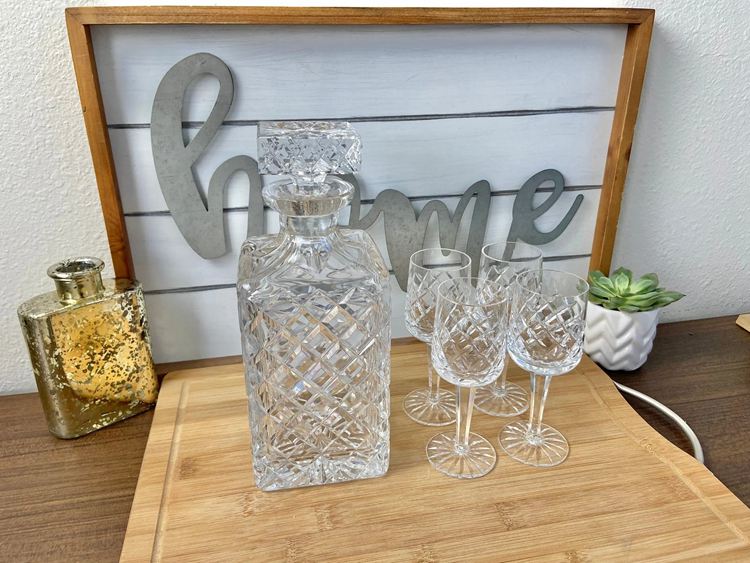
In addition, the value of kitchen glass has been more consistent over the last several years, and most standard products are currently sold for less than $15. On the other hand, the value of rare goods may often reach many hundreds of dollars.
The Jeannette glass company and its bottle work was a prominent producer of many types of glassware for the kitchen. Their glass bottle marks helped as the identification marks.
Milk Glass
Also referred to as opaque glass, milk glass was very well-liked throughout the 19th century but began to see a decline in popularity during the early parts of the 20th century. It offered a more affordable alternative to glass produced in China and Europe.
Despite the fact that its name indicates otherwise, it is really offered in a wide variety of colors in addition to white. Between the years 1940 and 1950, milk glass was brought back into the spotlight, and ever since then, it has been highly sought by a collector.
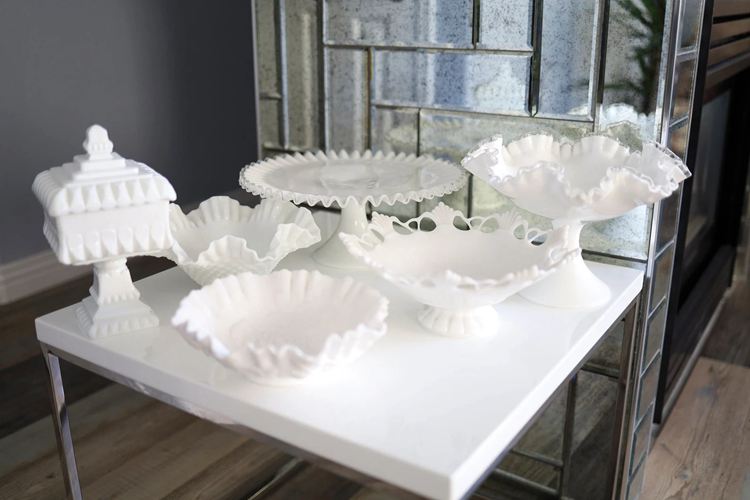
Vintage Milk Glass ball canning jars
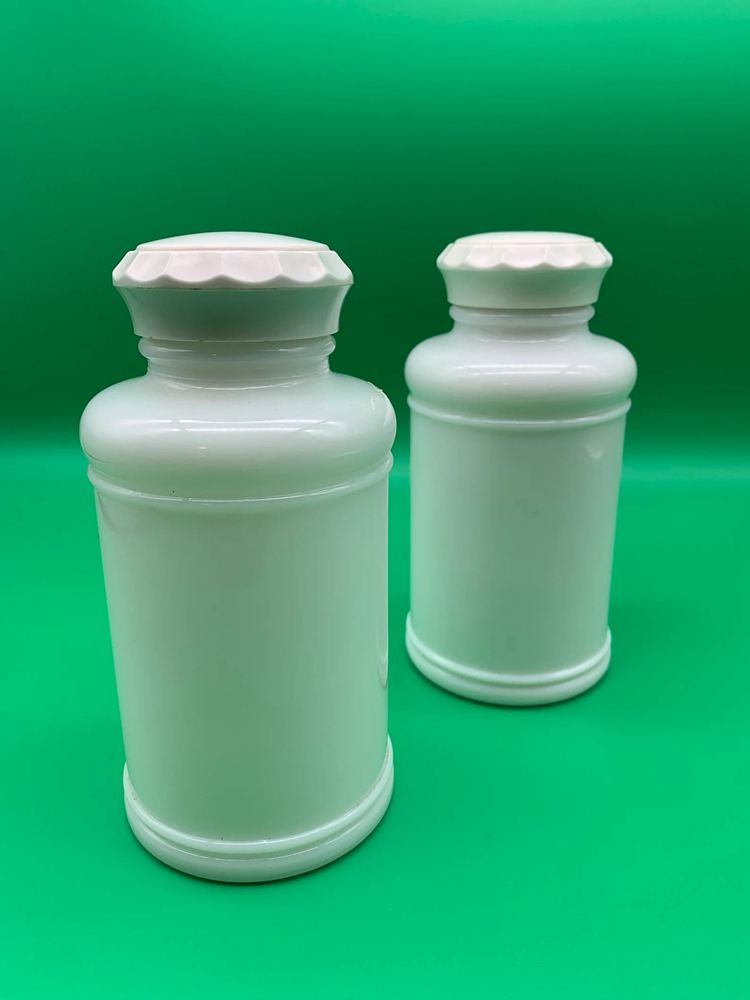
Vintage Hobnail Bud Vase
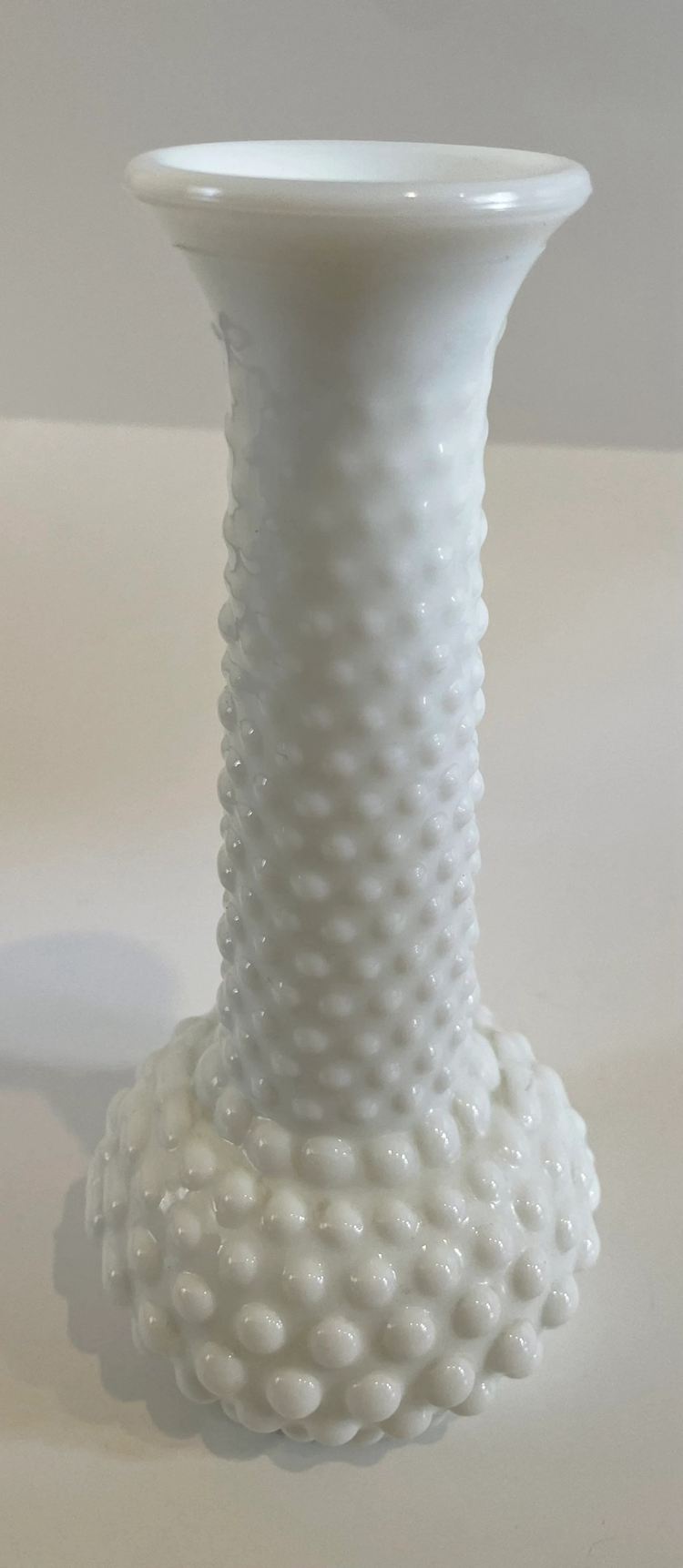
Vintage 1950’s Milk Glass Candy dish
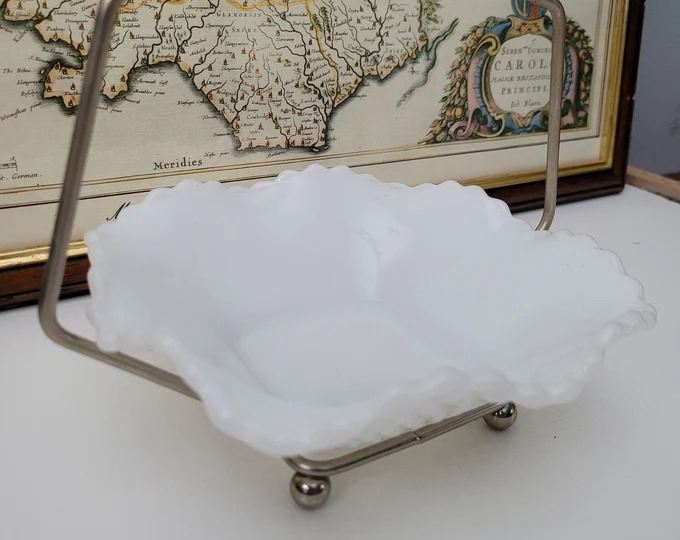
Vintage 1960’s White milk glass Laced edge Candy dish
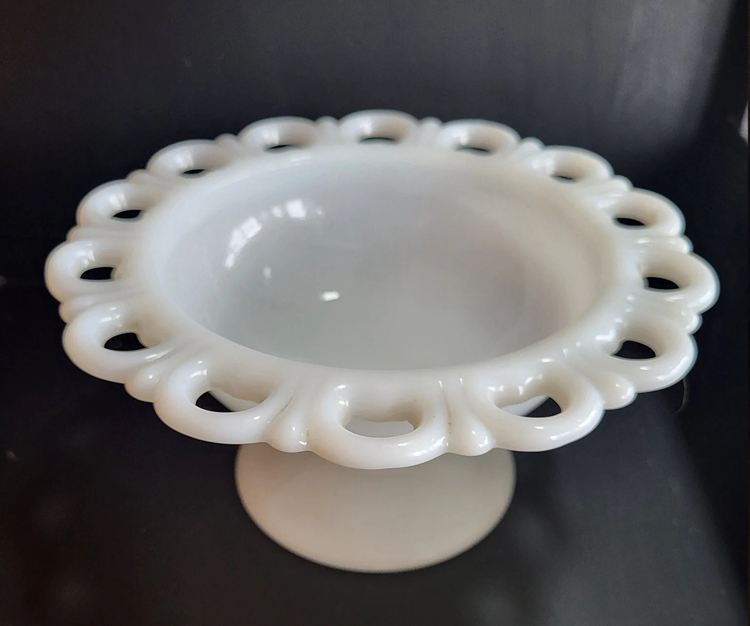
Old milk glassware is considered to be the most valuable kind of milk glassware. This type of milk glassware was produced between the middle of the 19th century and the early parts of the 20th century.
Additionally, older pieces of milk glass often have designs on them, such as boats and other kinds of animals. In addition to that, they feature molded edges that give the appearance of latticework.
In addition, ancient pieces are characterized by their opalescence, smoothness, and distinct mold lines. The ring of fire is another characteristic that sets ancient milk glassware apart from modern examples.
In conclusion, the vast majority of milk bottle collectors still seem for them. They were manufactured by the best American bottle company. These included Fenton, Kemple, Westmoreland, and Atterbury & Company.
Antique Glass Identification Marks
Even if you are probably not an expert in knowing what each and every scratch on antique glass pieces implies, you may figure out some of the most prevalent ones yourself by using these simple antique glass markings guiding principles:
It is not unusual to find glass that is not marked
The majority of older pieces of glass do not have any marks on them. Examine the underside carefully for excessive wear as well as scratches. It’s possible that the piece’s gilding will exhibit indications of deterioration over time.
Acid badges
The term “acid badge” refers to a specific kind of branding that was often used as a glass maker’s logo. A lot of glassware can be recognized by these acid badges. These act as antique glass markings.
Registration marks
There are registration numbers on a great number of pieces of glass that were made after the middle of the 1800s. The presence of a diamond mark presents the best antique glass markings, which indicates that the design has been registered, may be seen on earlier items.
Engraved glass signatures
When an artist signed a piece of engraved glass, it was included in the design of the item, and the signature was often rather tiny. However, it is still considered as antique glass markings for identifying antique glass. Many signed art glass pieces can be found even today.
Sign cut glass pieces
After 1905, it became standard practice for enterprises that produced cut glass pieces to sign the pieces in an effort to prevent their designs from being duplicated by competitors. These sign cut glass pieces helped in recognizing of them.
Etched glass
Quite often, the numbers were etched into the peg of the stopper as well as the bottle’s neck. These numbers are also kind of antique glass markings.
It is important that the numbers on glass stoppers and bottles or bottle’s neck match. They should essentially be from the same mold.
Glassware from the 1800s and 1900s that has glass stoppers, such as a perfume bottle or a decanter, should have numbers that correspond with each other on both the stopper and the particular bottle or bottle’s neck.
If your item has a glass mark or logo that you are not acquainted with, the best place to look to identify the mark is in a antique glass markings identification guide or a glass pricing and identification guide. Both of these guides may be found at a bookstore or online.
The majority of these guidelines are specific to a single kind of antique glass markings, such as carnival glass, depression glass, or early American pressed glass. Only a tiny portion of the books that are now available are represented by the following titles:
- Collectible Drinking Glasses: Identification & Values by Michael Kelly and Mark E. Chase
- Peachblow Glass: Collector’s Identification & Price Guide by Johanna and Sean Billings
- Art Glass: Identification & Price Guide by John A. Shuman
- Warman’s Glass: Values and Identification Guide
- American Slag Glass: Identification and Values
- Carnival Glass: The Best of the Best
- Makers and Their Marks
In the field of the internet, we not only have books and manuals, but we also have a vast reservoir of knowledge via the resources that are available online. These materials will most certainly expand your knowledge, and in comparison to books and manuals, they are far simpler to obtain. With their help you may identifying antique glass markings easily!
Manufacturers of Antique Glass
Since the beginning of the Industrial Revolution, glass manufacturers have been producing uncountable pieces of glass in a wide variety of shapes, sizes, colors, and patterns. They have their particular glass markings. There are a lot of well-known glass manufacturers and designs including the following:
Cambridge Glass Company
In addition to transparent, opaque, and opaque black glass, Cambridge glass company also manufactured glass in a variety of other colors. Their well-known brand identifier is a capital letter “C” enclosed inside a triangle with equal sides. These manufacturers marks are present on many of the items. However, this signature is not present on every item.
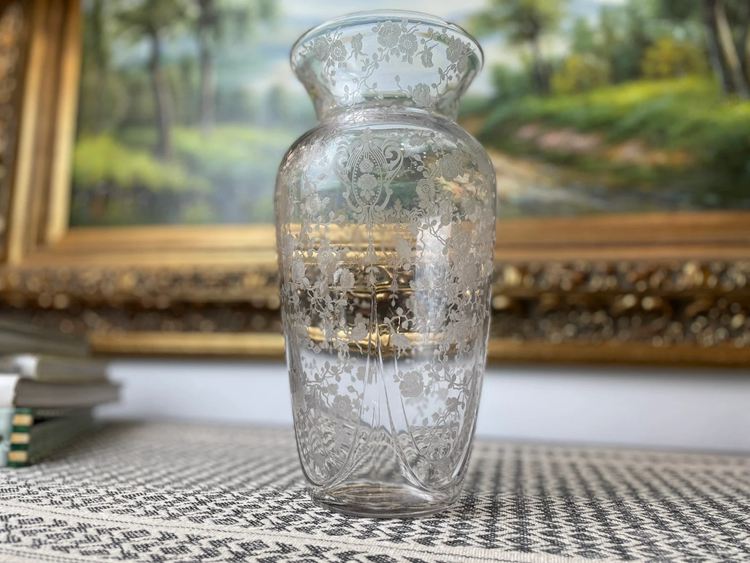
The rosepoint pattern by Cambridge glass company has been the most popular one. It has been really important during and after the industrial revolution.
Jeannette Glass Company
The “J” of the square mark used by the Jeannette Glass Company is inverted so that it can be seen through the bottom of the glass while looking inside. This allows the brand to be seen as if it were upside down. These Jeannette glass company’s glass manufacturers marks help identifying antique glassware from this company.
The logo was discovered on glass from a soda fountain that dates back to the 1950s. The Adam pattern made by Jeannette Glass Company has been a big hit.
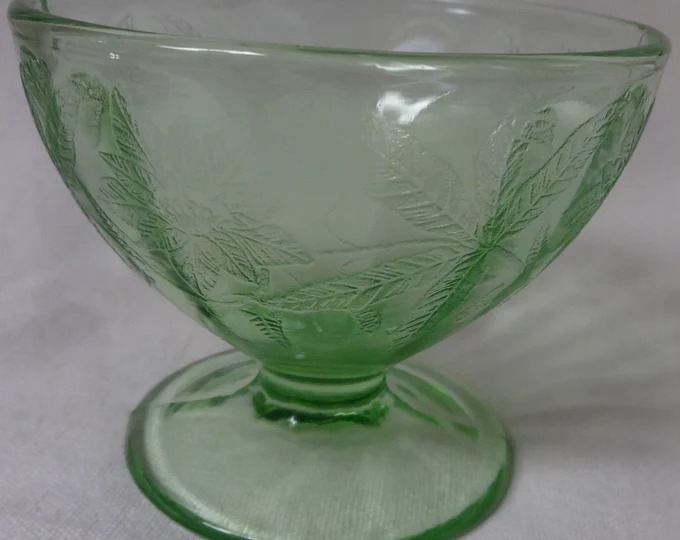
The majority of the dinnerware produced by the Jeannette Glass Company was not labeled. Generally speaking, the things that have been marked are footed pieces like goblets and glasses of various kinds.
On occasion, Jeannette might designate themselves with a “J” in the shape of a triangle or just a “J” by itself.
Libby Glass Company
The logo consisting of a “cursive L” is often seen embossed on the bases of a variety of glassware products intended for use in residential settings as well as in commercial and institutional settings.
Both Toulouse and Peterson are credited with introducing the “cursive L” inside an ordinary circle or ring in 1955. In practical use, this mark will often be seen to be upside down when seen from the outside of the glass while looking at the base.
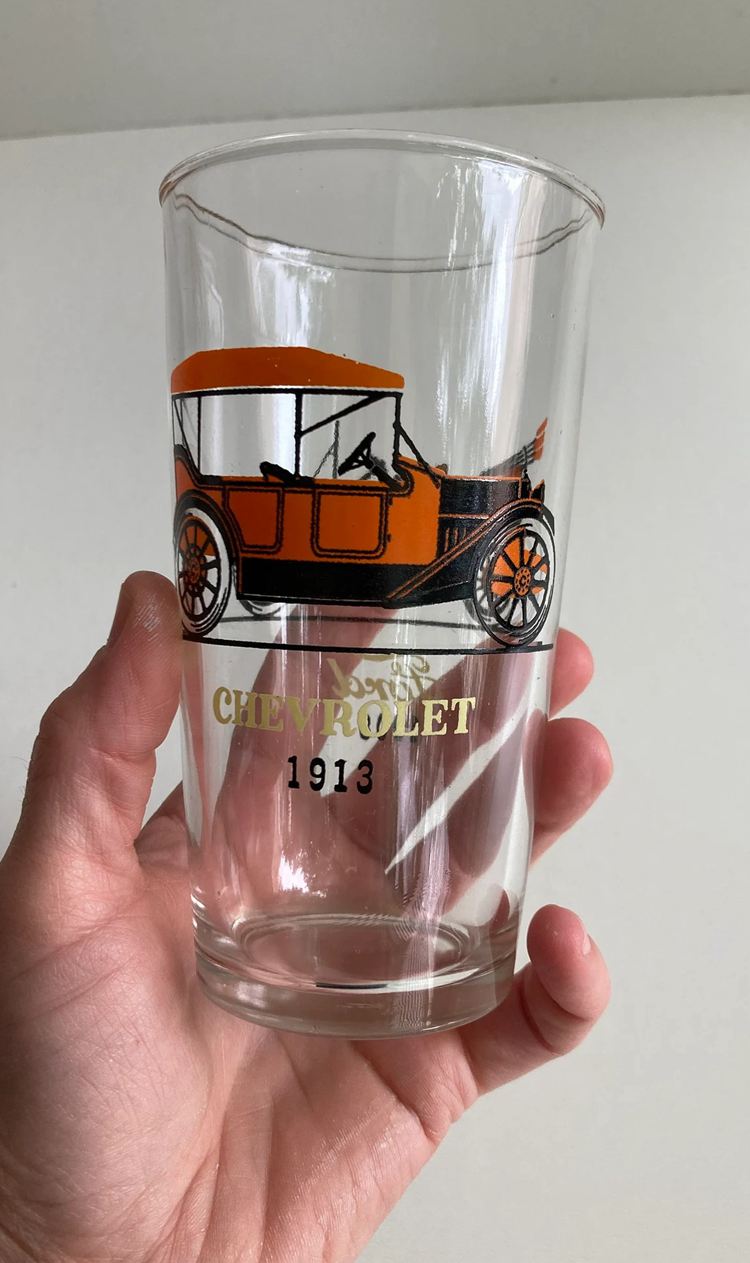
On the other hand, when viewed from inside the glass, it will naturally be seen to be in the right orientation. The Silhouette pattern made by the Libby glass company is one of its kind of many antique glass pieces.
Tiffany pastel glass
In 1892, Tiffany received a patent for the Favrile style of glass. It is usual for Favrile glass to exhibit a surface iridescence, which is a distinguishing quality that may be found in some types of glass that date back to classical antiquity.
Among many antique glass pieces, Tiffany’s pastel glass still stands out.
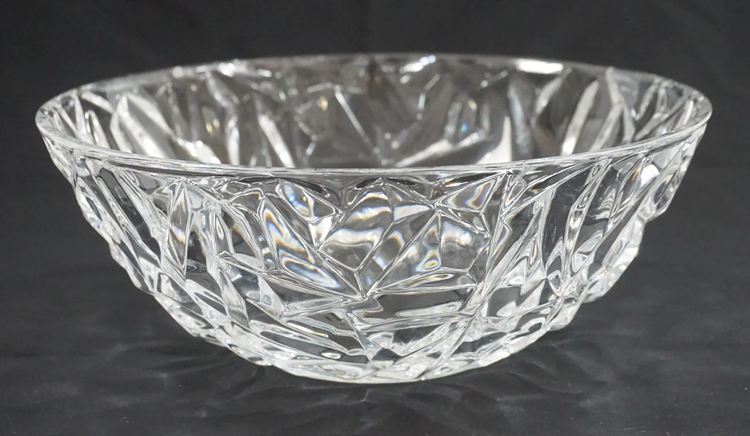
This iridescence gives the surface a shimmering appearance, but it also makes the surface of glass containers somewhat opaque. Tiffany pastel glass manufacturers produced one of the best antique glassware.
Roden Brothers of Montreal
Butterfly and Floral patterns by the Roden Brothers of Montreal are their best products. Roden Brothers glassware company was located in Canada. This company was established on June 1st, 1891 by brothers Thomas and Frank Roden in Toronto, Canada.
It was known as Roden Bros. Ltd. in the 1910s, and Henry Birks and Sons purchased it in 1953. However, it has been amazing glass manufacturers in its time.
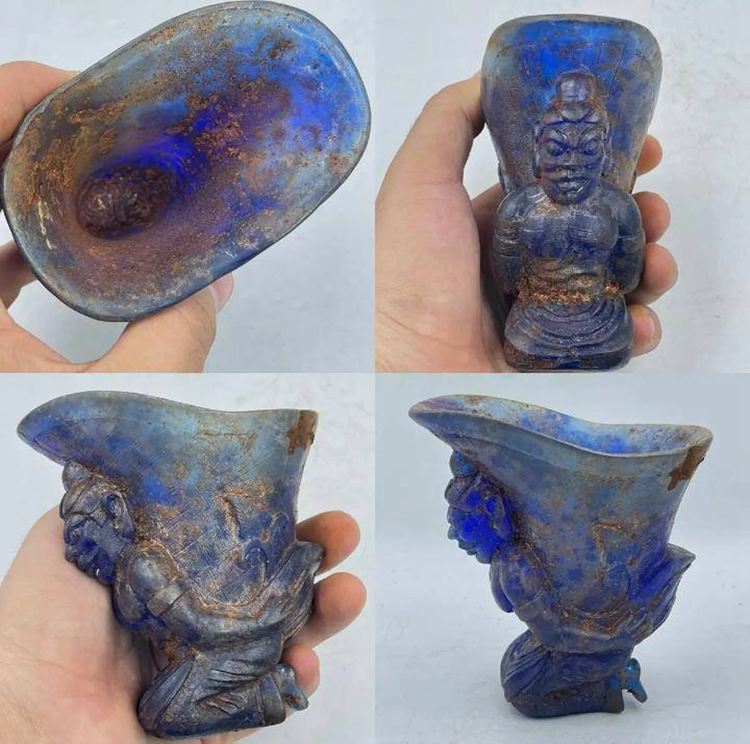
Roden Bros. Ltd. made a gold rose bowl with the royal journey through Canada etched on it for King George VI and Queen Elizabeth in 1939, a tea set for Princess Elizabeth’s 1947 wedding, and they were credited with helping construct the Stanley and Grey Cups.
Dugan Glass Company
Beaded shell pressed glass is the signature of the Dugan glass company. From 1892 until 1896, Dugan Glass was known as the Indiana Glass Company, based in Indiana, Pennsylvania. Harry Northwood took over the firm and renamed it Northwood in 1896. Harry Bastow and Thomas E.A. Dugan led the National Glass Company from 1900 until 1903.
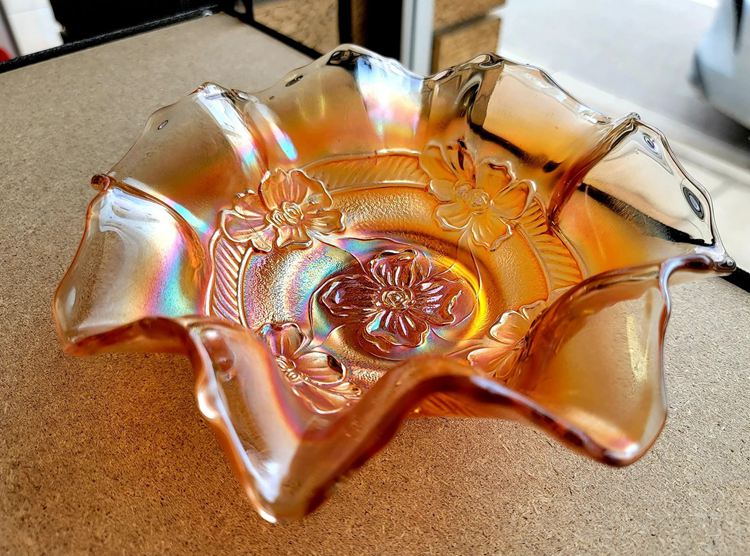
Known as the Dugan Glass Company for a short period of time (1904–1909), the company produced Carnival glass under the “Diamond-D” brand. Finally, it was known as the Diamond Glass Company from 1913 until it was forced to close due to a factory fire in 1931.
However, it still remains one of the best beaded shell pressed glass manufacturers with a diamond mark for identification.
Is there an app to identify vintage glassware?
ValueMyStuff is able to give values and assessments for a wide variety of items, including antique glass. You submit a photo of whatever you want to be evaluated. If you have any antique glass marks or the glass company logo, you can submit them as well.
The specialists will have a look at it for a charge.
All of the professionals have worked for Sotheby’s, Christie’s, or one of the other big auction houses. Hence, they know the antique glass marks really well.
Where to Shop Antique Glass From?
When it comes to hard-to-find things that aren’t available in local stores, buying antique glass online offers up a world of possibilities for antique collectors.
There have never been greater options for antique buyers, whether it’s locating bargains or seeing a local collection without ever leaving the comfort of their own home. There are risks, though, when you can’t really see or handle the object that you are purchasing.
Working with reliable merchants that stand behind their products is the best way to ensure a positive purchasing experience. They also help you get the best glass price as well as an insight into the glass piece’s past. To find some of the earlier pieces of glass, look into these sites:
- eBay
- Etsy
- Sotheby’s
- 1st Dibs
- RubyLane
Take Away
Antique glass marks assist unravel the riddle of the history of the old glass item by offering clues for identification, as well as for establishing the worth and authenticity of the antique glass pieces.
To observe these marks in person, you don’t even need to have an extensive collection. It’s pretty easy for seasoned collectors to determine different marks found that are typically hidden.
From the 18th century up to the present day, the market for antique glass has seen a roller coaster of booms and busts. However, art nouveau, cut glass, and many others have seen an all-time high.
You will need to educate yourself on the properties and makers of the collectibles you want to buy in order to guarantee that you make the appropriate purchases. Learn about the glass marks, acid badge marks, artist signed, and paper label marks to find out about the glass piece’s past.





![Where To Sell Antique Furniture In 2022 [Ultimate Guide]](https://www.jacquelinestallone.com/wp-content/uploads/2022/09/Etsy-Your-Place-To-Buy-And-Sell-All-Things-Handmade-600x450.jpg)


